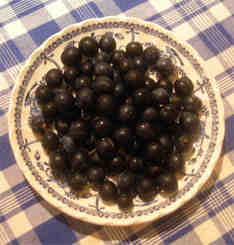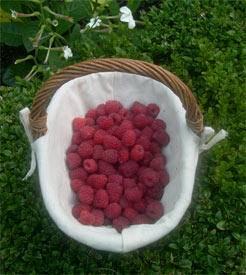Fermented sloe gin recipe: a new approach to making sloe gin
Posted by Fiona Nevile in Liqueurs | 52 comments
A dish of innocent ripe sloes waiting to be transmorigified
I love sloe gin and like most other sloe gin makers am keen to make a great brew. I hate to admit it but it would be great to impress my liqueur making guru, Gilbert. This recipe gives me the possiblity of two great outcomes. This new technique may produce a superb sloe gin opera or rolling of drums.
Colin Boswell wrote, “The secret of a good sloe gin is the extent to which the very high natural tannin content plus its other constituents have been extracted. I have found that replicating, as perhaps you have above (that’s me!), red wine production by fermenting the sloes on their skins makes an outstanding sloe gin. What you must beware of is that too high a concentration of sugar will kill the yeast and no fermentation will take place.
Layer 2 inches of frozen sloes interspaced with 3 tablespoons of sugar then another 2 inches of sloes and so forth in a fermentation bucket. Add a port wine or high alcohol yeast, probably fermenting out to 14deg. The more technical can measure the specific gravity before and after fermentation to gauge the alcohol content and how much sugar needs to be added.
Stand in a warm place, keep a close eye on fermentation and add small amounts of sugar until fermentation ceases.
Fermenting will of course raise the alcohol content but more importantly it extracts the full flavours of the sloes which other methods fail to do.
I would greatly appreciate the views of an experienced amateur winemaker on this.”
We make wine but are in no way experienced winemakers. So I couldn’t comment intelligently on the method. Instead I decided to give this method a go. I must admit I never would have considered fermenting the sloes before adding the gin but I haven’t been thinking laterally as regards sloe gin. I can see the wisdom behind this method, upping the alcohol level before adding the gin. As Colin says, why let the sloes become imbued with the gin – unless you are going to use the sloes for something else (they can be added to mince pies, Christmas cake, chocolate or the boozy crumble that will have you mother-in-law finally sleeping in a heap under the table).
For this experiment I am using 2 pounds of sloes (900g). I am planning to use the fermented sloes for sloe sherry.
You can get a range of good red wine yeasts online from many sources. I use the art of brewing .
I asked Colin for the ratio mix of fermented sloes to gin and received this reply.
“6l fermented sloe juice to .4l gin, assuming sloe juice has reached 15% alcohol, will give sloe gin at 25%. 50/50 gives 27.5% alcohol. By comparison, if the sloe juice was not fermented, alcohol content at .6l/.4l gin is 16% and at 50/50 20%. The gin and sloe juice need at least two months, preferably longer but should be acceptable by Christmas.
I also recommend the addition of juniper berries, 10 to a gallon of sloes.”
Leave a reply






Hi Anne,
I think that the sharp frosts in April might have damaged your sloe blossom.
Hi Virginia,
Thanks for the update on the sloes in the Ross area.
Hi Pat,
That’s a shame that there are no sloes around where you live.
Thanks but live in a big housing estate. Don’t think we have any near by. They even took the lovely field that we used to walk in and built houses on it now.:(
Hi, last ime I looked (a couple of days ago) there were masses of sloes in the hedges round us in Herefordshire, Ross area. Perhaps someone got to yours first?
hi
is it a bad year for sloes? i went out yesterday with a large bag only to find that the bushes i usually find laden were bare!!! horror of horrors!! could be that someone else got there first of course – but they are on private land and away from footpaths. if anyone near hereford has sloes please ‘comment’
Hi Pat,
It might be worth asking your neighbours if there are sloes around where you live. If you have a local general store/Post Office they would probably know as well.
Thanks Fiona, I can’t say I have seen any around here. Hmmm Wonder if I can talk Brian into a nice walk.
Hi Mordsith,
I am a permanent novice – things move so fast, I am usually having fun. Sometimes my hair is standing on end but that is only when my wine has stopped murmuring when it should be talking to me.
Oh, I wish my blog was as interesting and informative as yours! You have inspired me to make quince jelly and to have a go at the fermented sloe gin next time. We only have two gallons this year!
Many thanks for sharing all your experience with us novices!
Hi Pat,
Sloes are small round fruit on a straggly sort of thorny hedge. There is a picture of sloes on a bush here http://www.cottagesmallholder.com/?p=442
They are the size of a small marble.
Once you have tasted a great sloe gin you would crawl miles on your knees to find them. Sloe gin is the quintessential UK liqueur and the best is always home made.
Thanks for the lovely blog. I am still not 100 percent what a sloe looks like. The recipe sounds rather delicious though!!!